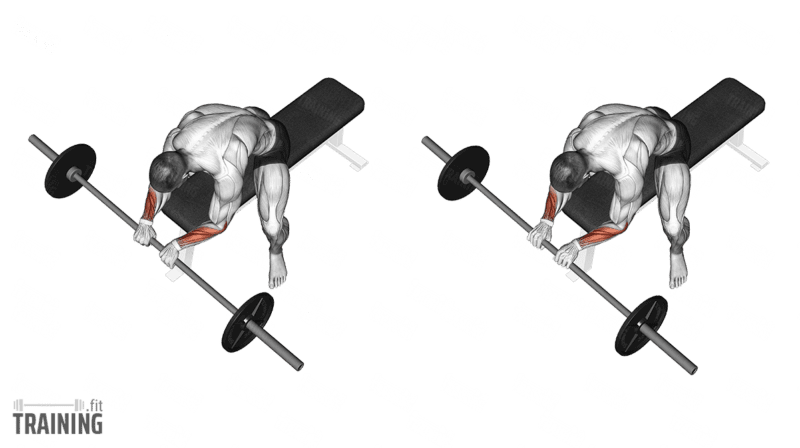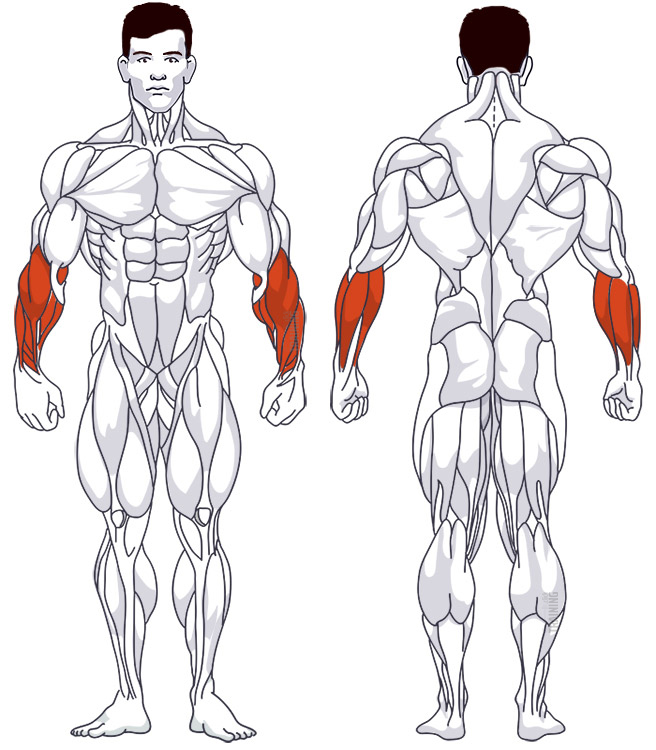Barbell Wrist Curl
Isolation exercise, Free weightsOverview

Main muscles
- Forearm: Finger extensor
(Musculus extensor digitorum) - Forearm: Short radial hand extensor
(Musculus extensor carpi radialis brevis) - Forearm: Long radial hand extensor
(Musculus extensor carpi radialis longus) - Forearm: Brachioradialis
(Musculus brachioradialis)
Training plans
Barbell Wrist Curl is a suitable substitute for similar exercises in or as a supplement to various training plans.
Barbell Wrist Curl: Basics and alternatives

Involved main muscle groups:
Barbell Wrist Curl
The Barbell Wrist Curl is a great exercise for isolating and strengthening your forearm muscles. By gripping a barbell with an overhand grip and moving it up and down using your wrists, you’ll effectively work your forearms. Besides this variation, there are other options like dumbbell wrist curls, hammer grip wrist curls, and reverse grip barbell wrist curls to incorporate into your workout routine.
Correct Execution
Performing overhand grip wrist curls is pretty straightforward and can be done in two different ways:
- Rest your forearms or elbows on a flat bench (as shown in the image above) with the barbell hanging off the edge, or
- Place your forearms on your knees, holding the barbell in front of your shins.
Choose the variation that feels best for you and doesn’t cause wrist pain. The version where you support your forearms on your thighs or knees is explained below.
To achieve better muscle balance, make sure to also include an underhand grip wrist curl exercise in your training to work the flexors.
Video Tutorial
Step-by-Step Instructions
Sit on the end of a flat bench with the barbell on your thighs.
Grab the barbell using an overhand grip (back of your hand facing up) about shoulder-width apart, and lift it slightly. At the same time, spread your legs to approximately shoulder-width apart.
Rest your forearms on your thighs, allowing your wrists to extend beyond your knees. Keep holding the barbell firmly in an overhand grip.
Bend your wrists as far as possible without moving your forearms to reach the starting position.
Slowly lower your wrists down while keeping the tension steady. Don’t let the weight rest on your wrists or legs.
Next, lift your wrists back up by bending them and bring the barbell to the starting position.
Common Mistakes
During the exercise, keep tension in your forearms and avoid using your wrists for relief. Your wrists should only move the weight, not support it. Otherwise, you’ll lessen the training effect and potentially increase the risk of painful joint strain.
Avoid using momentum, too. Perform wrist curls slowly and with control, and if necessary, reduce the weight to ensure proper form.